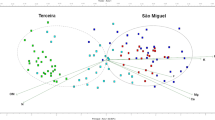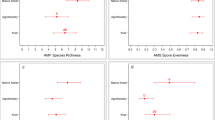Abstract
Arbuscular mycorrhizal fungi (AMF) spore density and root colonization are considered sensitive to host species and abiotic factors such as climate and soil. However, there is a knowledge gap about how fragmented native forest remnants might contribute to AMF conservation, what is the AMF spore density and root colonization, and to what extent climate change, particularly warming, might impact AMF. The aim of the study was to quantify the AMF spore density and root colonization along altitudinal gradients in three agro-ecological zones of nine church forests in northern Ethiopia. Data were collected from 45 plots. All the surveyed church forest species were colonized by AMF. However, we found a significant (p < 0.05) decrease in root colonization and AMF abundance in forests at high elevation. The topsoil had significantly (p < 0.05) higher root colonization and AMF abundance than subsurface soil. We found strong negative correlations between altitude and both spore density and root colonization and soil fertility. While we cannot separate whether spore density was temperature or soil limited, we can demonstrate the importance of conserving certain tree species, particularly Ficus species, which harbor high spore densities, in both lowland and midland church forests. In the highland, no Ficus species were found. However, Hagenia abyssinica, another Rosales, had the highest spore density in the highland ecoregion.



Similar content being viewed by others
References
Laurance WF (2005) When bigger is better: the need for Amazonian mega-reserves. Trends Ecol Evol 20(12):645–648
Wassie A, Bongers F, Sterck FJ, Teketay D (2010) Church forests– relics of dry Afromontane forests of Northern Ethiopia: opportunities and challenges for conservation and restoration. In: Bongers F, Tennigkeit T (eds) Degraded Forests in Eastern Africa: Management and Restoration. Earthscan, pp 123–132
Aerts R, Van Overtveld K, Haile M, Hermy M, Deckers J, Muys B (2006) Species composition and diversity of small Afromontane forest fragments in northern Ethiopia. Plant Ecol 187(1):127–142
Jacob M, Frankl A, Beeckman H, Mesfin G, Hendrickx M, Guyassa E, Nyssen J (2015) North Ethiopian afro-alpine tree line dynamics and forest-cover change since the early 20th century. Land Degrad Dev 26(7):654–664
Ray R, Chandran MS, Ramachandra TV (2014) Socio-cultural protection of endemic trees in humanised landscape. Biodivers Conserv 23(8):1977–1994
IBC (2009) Convention on Biological Diversity (CBD) Ethiopia’s 4th Country Report. Institute of Biodiversity Conservation, Addis Ababa
Myers N, Mittermeier RA, Mittermeier CG, Da Fonseca GA, Kent J (2000) Biodiversity hotspots for conservation priorities. Nature 403(6772):838–853
Berruti A, Borriello R, Orgiazzi A, Barbera AC, Lumini E, Bianciotto V (2014) Arbuscular mycorrhizal fungi and their value for ecosystem management. In: Grillo O (ed) Biodiversity: The Dynamic Balance of the Planet. InTech, Rijeka, pp 159–191
Smith SE, Read DJ (2010) Mycorrhizal symbiosis. Academic press. Mycologia 104(1):1–13
Birhane E, Gebremedihin KM, Tadesse T, Hailemariam M, Solomon N (2017) Exclosures restored the density and root colonization of arbuscular mycorrhizal fungi in Tigray, Northern Ethiopia. Ecol Process 6(1):12–33
Berhane A, Totland Ø, Moe SR (2013) Woody plant assemblages in isolated forest patches in a semiarid agricultural matrix. Biodivers Conserv 22(11):2519–2535
Birhane E, Hailemariam M, Gebresamuel G, Araya T, Hadgu KM, Norgrove L (2020) Source of mycorrhizal inoculum influences growth of Faidherbia albida seedlings. J For Res 31:313–323
Birhane E, Gebretsadik KF, Taye G, Aynekulu E, Rannestad MK, Norgrove L (2020) Effects of forest composition and disturbance on arbuscular mycorrhizae spore density, arbuscular mycorrhizae root colonization and soil carbon stocks in a dry Afromontane forest in northern Ethiopia. Diversity 2(4):133. https://doi.org/10.3390/d12040133
Berruti A, Lumini E, Balestrini R, Bianciotto V (2016) Arbuscular mycorrhizal fungi as natural biofertilizers: let’s benefit from past successes. Front Microbiol 6:1541–1559
Tesemma A, Tengnäs B (2007) Useful trees and shrubs of Ethiopia: identification, propagation, and management for 17 agroclimatic zones. RELMA in ICRAF Project, World Agroforestry Centre, Eastern Africa Region
Kidanemariam A, Gebrekidan H, Mamo T, Kibret K (2012) Impact of altitude and land use type on some physical and chemical properties of acidic soils in Tsegede Highlands, northern Ethiopia. Open J Soil Sci 2(3):114–223
WRB F (2006) World reference base for soil resources 2006-a framework for international classification, correlation and communication. World soil resources reports. Food and Agriculture Organization of the United Nations, Rome, 128
Nyssen J, Vandenreyken H, Poesen J, Moeyersons J, Deckers J, Haile M, Govers G (2005) Rainfall erosivity and variability in the Northern Ethiopian Highlands. J Hydrol 311(4):172–187
NMA (2017) National Meteorological Agency: rainfall and temperature data (2007-2016) in Maigaba, Adiremets, and Ketemanigus areas. Mekelle, Ethiopia
Friis I, Demissew S, Van Breugel P (2010) Atlas of the potential vegetation of Ethiopia. Det Kongelige Danske Videnskabernes Selskab, Copenhagen, Denmark
Bullock JM (2006) Plants. In: Sutherland WJ (ed) Ecological census techniques: a handbook, 2nd ed. Cambridge University Press, Cambridge, pp 186–213
Condit R (2008) Methods for estimating aboveground biomass of forest and replacement vegetation in the tropics. Center for Tropical Forest Science Research Manual, 25
Wassie A (2007) Ethiopian church forests: opportunities and challenges for restoration. PhD thesis, Wageningen University, Wageningen, The Netherlands. ISBN: 978-90-8504-768-1
Hedberg I (2009) The Ethiopian Flora Project-an overview. Flora Ethiopia Eritrea 8:1–7
Dagne E (2011) Natural Database for Africa (NDA). Retrieved December 2, 2017, from http://www.htmlexe.com
Brundrett M, Bougher N, Dell B, Grove T, Malajczuk N (1996) Working with mycorrhizas in forestry and agriculture (No. 435-2016-33680). Australian Centre for International Agricultural Research, Canberra
Birhane E, Kuyper TW, Sterck FJ, Bongers F (2010) Arbuscular mycorrhizal associations in Boswellia papyrifera (frankincense-tree) dominated dry deciduous woodlands of northern Ethiopia. For Ecol Manag 260(12):2160–2169
Giovannetti M, Schubert A, Cravero MC, Salutini L (1988) Spore production by the vesicular-arbuscular mycorrhizal fungus Glomus monosporum as related to host species, root colonization and plant growth enhancement. Biol Fertil Soils 6(2):120–124
Brundrett MC, Piche Y, Peterson RL (1994) A new method for observing the morphology of vesicular–arbuscular mycorrhizae. Can J Bot 62(10):2128–2134
Gee GW, Bauder JW (1986) Particle-size analysis 1 (No. methodsofsoilan1). Soil Science Society of America, American Society of Agronomy, pp 383–411
Walkley A, Black IA (1934) An examination of the Degtjareff method for determining soil organic matter, and a proposed modification of the chromic acid titration method. Soil Sci 37:29–38
Bray RH, Kurtz LT (1945) Determination of total, organic, and available forms of phosphorus in soils. Soil Sci 59(1):39–46
van Reeuwijk LP (1993) Procedures for soil analysis, 6th ed. International Soil Reference and Information Centre, Wageningen
Bremner JM, Mulvaney CS (1983) Nitrogen—Total. In: Page AL (ed) Methods of soil analysis: Part 2 chemical and microbiological properties, 2nd ed. American Society of Agronomy, Inc., pp 595–624
Van Reeuwijk LP (1995) Procedures for soil analysis. Technical Paper 9. Wageningen, International Soil Reference and Information Centre
Haschke P (2017) An introduction to R. “Kite-Eating Tree” R version 3.4.3. Asheville
Birhane E, Aynekulu E, Mekuria W, Endale D (2011) Management use and ecology of medicinal plants in the degraded dry lands of Tigray, Northern Ethiopia. J Med Plants Res 5(3):308–319
Picone C (2000) Diversity and abundance of arbuscular–mycorrhizal fungus spores in tropical forest and pasture 1. Biotropica 32(4a):734–750
Tao L, Jianping L, Zhiwei Z (2004) Arbuscular mycorrhizas in a valley-type savanna in southwest China. Mycorrhiza 14(5):323–327
Hrynkiewicz K, Baum C (2012) The potential of rhizosphere microorganisms to promote the plant growth in disturbed soils. In: Malik A, Grohmann E (eds) Environmental protection strategies for sustainable development. Strategies for Sustainability. Springer, Dordrecht, pp 35–64
Zeleke G, Abebe T, Haile W (2015) Ficus vasta L. In parkland Agro forestry practices of Hawassa Zuria district, Southern Ethiopia. Ethiopian J Nat Resour 15(1):1–14
Kahiluoto H, Ketoja E, Vestberg M, Saarela I (2001) Promotion of AM utilization through reduced P fertilization 2. Field studies. Plant Soil 231(1):65–79
Belay Z, Vestberg M, Assefa F (2013) Diversity and abundance of arbuscular mycorrhizal fungi associated with acacia trees from different land use systems in Ethiopia. Afr J Microbiol Res 7(48):5503–5515
Wu Y, Liu T, He X (2009) Mycorrhizal and dark septate endophytic fungi under the canopies of desert plants in Mu Us Sandy Land of China. Front Agric China 3(2):164–170
Zhu YG, Miller RM (2003) Carbon cycling by arbuscular mycorrhizal fungi in soil–plant systems. Trends Plant Sci 8(9):407–409
Schmidt SK, Sobieniak-Wiseman LC, Kageyama SA, Halloy SRP, Schadt CW (2008) Mycorrhizal and dark-septate fungi in plant roots above 4270 meters elevation in the Andes and Rocky Mountains. Arct Antarct Alp Res 40(3):576–583
Lugo MA, Ferrero M, Menoyo E, Estévez MC, Siñeriz F, Antón A (2008) Arbuscular mycorrhizal fungi and rhizospheric bacteria diversity along an altitudinal gradient in South American Puna grassland. Microb Ecol 55(4):692–705
Burni T, Bibi S, Sarah S (2012) Morphological characteristics of arbuscular mycorrhizal association in Plantago Ovata Forsk. Putaj Sci 19:155–161
Birhane E, Teketay D, Barklund P (2006) Actual and potential contribution of exclosures to enhance biodiversity of woody species in the drylands of Eastern Tigray. J Drylands 1(2):134–147
Sarkar U, Choudhary BK, Sharma BK (2014) Vascular arbuscular mycorrhizal (VAM) spore diversity and density across the soil of degraded forest and rubber plantation in Tripura, India. Am-Eurasian J Agric Environ Sci 14:1080–1088
Acknowledgements
The authors are grateful to the “steps towards Sustainable Forest Management with the Local Community in Tigray, northern Ethiopia NORAD/NORHED (ETH 13/0018)” project for the financial support. We acknowledge the Water Land Ecosystems program of the CGIAR.
Author information
Authors and Affiliations
Corresponding author
Rights and permissions
About this article
Cite this article
Birhane, E., Gebregergs, T., Hailemariam, M. et al. Root Colonization and Spore Abundance of Arbuscular Mycorrhizal Fungi Along Altitudinal Gradients in Fragmented Church Natural Forest Remnants in Northern Ethiopia. Microb Ecol 82, 233–242 (2021). https://doi.org/10.1007/s00248-021-01744-5
Received:
Accepted:
Published:
Issue Date:
DOI: https://doi.org/10.1007/s00248-021-01744-5




